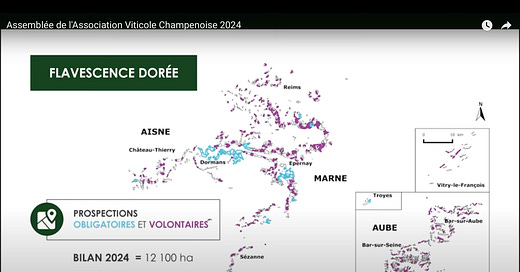Flavescence Dorée (FD) has often been compared to phylloxera. `Both diseases have their origin in North America, they are caused by infected insects that transfer the disease while feeding on the vine, and both maladies are involuntary propagated by human vineyard workers. But most importantly, both diseases have the potential to destroy swaths of vineyards in a record time. For instance, after its introduction in the late nineteenth century, phylloxera destroyed nearly all vineyard surfaces in Europe, and European winegrowers have long feared FD could be just as deadly.
FD is a lethal phytoplasma disease of the vine, belonging to the grapevine yellowing disease group. The bacterial agent Candidatus Phytoplasma vitis is spread from vine to vine by the infected cicadellid leafhopper, Scaphoideus titanus. Several studies have shown that leaf hoppers may be infected by other plant hosts as well as infected vines, and the infection may be passed on through eggs resulting in infected nymphs.
FD is passed on every time the infected leafhopper or nymph feeds on a vine, and this vine-to-vine propagation is thus epidemic in nature. Moreover, infected vines will show no symptoms till about a year later, making it harder to adequately pinpoint FD breadth and reach.
Once symptoms do start to show, they manifest as leaf yellowing for white grape varieties and leaf reddening for red grape varieties, downward leaf curling, stumped cane lignification, with plants bending to the ground in a weeping posture, black spots near the base of the shoots, flower abortion and berry shrivel with significant losses in berry quality and yields. Like phylloxera, FD will eventually lead to vine death, with young vines being at a greater risk.
As of yet, there is no cure although recovery can occur naturally in some rare cases, according to several academic studies. Nevertheless, seeing the extreme contagious nature of the disease, EU regulation as well as French law requires the eradication of the diseased vine through vine pulling as well as an insecticide treatment to eliminate potentially contaminated leafhoppers.
FD was first discovered in western France in the fifties. Since then it has spread across most traditional winegrowing regions in Europe. One of the possible reasons for this vast spatial spread may the intense multiplication of American rootstock in nurseries of western France, which subsequentially made their way across Europe. A common hypothesis of many scientific studies on the subject is that Scaphoideus titanus. leafhopper eggs were transported with the rootstock, which may or may not have been infested by the FD disease, thus introducing the vector and disease phytoplasma in all major winegrowing regions. Add to this that FD has often manifested itself through a crisis-recovery-relapse disease cycle, resulting in significant financial, social and ecological damage for winegrowers and regions trying to fight the disease. For instance, in 2005, the European Union (EU) and the Italian government paid out €34 million to compensate Piedmonte growers impacted by FD for yield losses and replanting.
Eleven years ago, the first case of FD was discovered in the Champagne region, and the last few years the disease has manifested in several areas. The CIVC technical team first rang the alarm bell in 2014. Since then they have taken every opportunity to convince Champagne growers of the severity of the disease, so far with mixed results.
Keep reading with a 7-day free trial
Subscribe to Terroir Champagne to keep reading this post and get 7 days of free access to the full post archives.




